Understanding the Importance of Grave Detail
Grave detail refers to the comprehensive documentation, preservation, and maintenance of burial site information, including marker inscriptions, location data, and historical records. This term encompasses both the physical aspects of grave maintenance and the detailed record-keeping essential for cemetery management and genealogical research.
| What is "Grave Detail"? | Key Components |
|---|---|
| Definition: Comprehensive documentation and maintenance of burial sites | 1. Marker inscriptions and epitaphs |
| Primary Uses: Cemetery management, genealogy, historical research | 2. Precise location mapping |
| Key Records: Names, dates, relationships, military service | 3. Photographic documentation |
| Modern Tools: Digital registries, GIS mapping, preservation techniques | 4. Historical and biographical context |
The term "grave" traces back to Old English "græf" (meaning burial pit) and has evolved to encompass both the physical burial location and the solemn nature of death-related documentation. Proper grave detail serves multiple crucial functions beyond simply marking a burial site - it preserves family histories, supports genealogical research, ensures legal compliance, and provides a focal point for remembrance.
In professional cemetery management, attention to grave detail includes:
- Accurate record-keeping of all interments
- Proper documentation of marker inscriptions
- Regular maintenance and preservation of physical markers
- Digital mapping and photography for archival purposes
- Compliance with local regulations and cultural practices
As the digital age transforms how we document and preserve historical information, grave detail practices have evolved from simple stone carvings to sophisticated database systems that can trace family connections across centuries.
I'm Mortuary Cooler, a national-level mortuary cooler supplier with extensive experience implementing grave detail documentation systems that ensure the dignified preservation of records alongside physical remains. My work with grave detail has shown how proper documentation and preservation technology directly impacts both operational efficiency and family satisfaction.
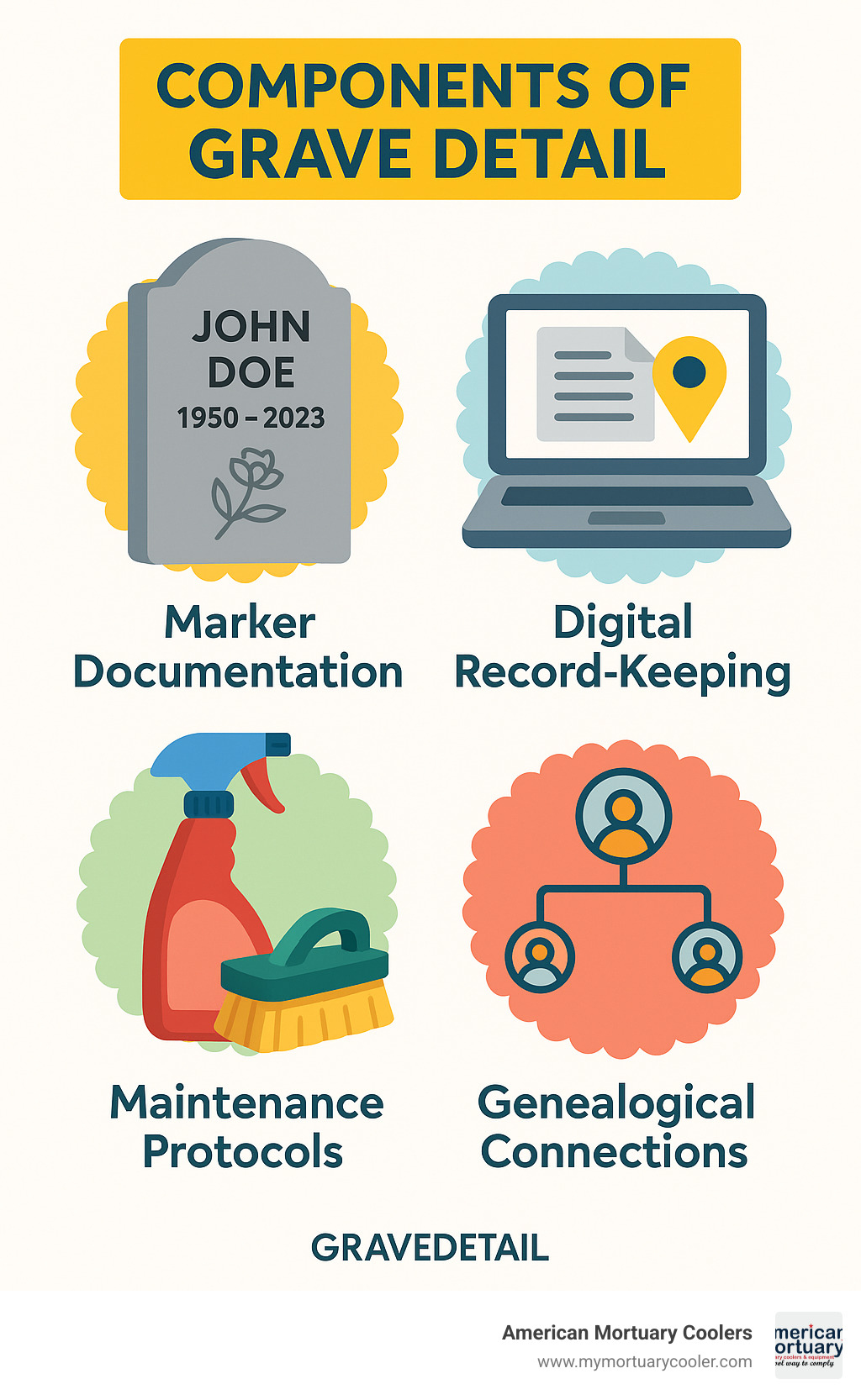
Grave detail terms simplified:
What Does "Grave Detail" Mean?
Have you ever noticed how some phrases carry more weight than others? Grave detail is one of those terms that does double duty in our language. In the funeral and cemetery world, it refers to the careful documentation and maintenance of burial sites and their records. But in everyday conversation, it can also mean providing serious, solemn, or extensive information about something.
This wonderful overlap makes the term perfect for cemetery work. When we document a grave site, we're not just collecting information—we're handling someone's final story with both precision and reverence. It's detailed work that deserves a grave approach.
Here at American Mortuary Coolers, when we talk about grave detail with the funeral homes we serve, we're referring to that meticulous process that honors both the physical resting place and the records that keep memories alive for generations to come.
Etymology & Linguistic Roots of "Grave"
Words carry histories, and "grave" has a particularly rich backstory. It comes from the Old English "græf," meaning a burial pit or cave. If we dig even deeper (pardon the pun), we find it originated from the Proto-Germanic "*graban," which simply meant "to dig"—the same root that eventually gave us common words like "groove" and "grub."
What makes "grave" fascinating is how it developed two parallel meanings that now complement each other:
As a noun, it's the physical burial place (from Old English "græf") As an adjective, it means serious or solemn (from Latin "gravis" meaning heavy or weighty)
Though these meanings developed separately, they've become beautifully intertwined in how we think about burial practices. The physical grave naturally calls for gravity of emotion and approach.
When we provide grave detail services in the funeral industry, we're honoring both traditions—approaching burial documentation with the precision it requires and the respect it deserves.
"Grave Detail" vs "Great/Minute Detail"
It's easy to confuse similar-sounding phrases, especially in conversation. Let's clear up how grave detail differs from its sound-alike cousins:
"Great detail" suggests thoroughness, usually with a positive or neutral feeling behind it. When your friend describes their vacation in "great detail," you're probably in for an enthusiastic story.
"Minute detail" focuses on the small, precise points—the tiny specifics that might otherwise be overlooked.
But grave detail brings something special to the table. It combines that necessary precision with an acknowledgment of solemnity. It recognizes that when we're documenting final resting places, we're doing more than collecting data—we're preserving legacies.
We've noticed in our years of serving funeral professionals that families appreciate thoughtful, respectful language when discussing arrangements for loved ones. Using "grave detail" instead of more casual terms helps maintain the right tone during sensitive conversations.
When a cemetery manager talks about improving their grave detail systems, they're not just upgrading record-keeping—they're enhancing how they honor and preserve the stories of those in their care.
Why Grave Detail Matters in Cemeteries and Memorials
The careful documentation and preservation of grave detail goes far beyond simply marking a burial spot. These records serve as the backbone of cemetery operations while nurturing our connection to history, family, and cultural heritage.
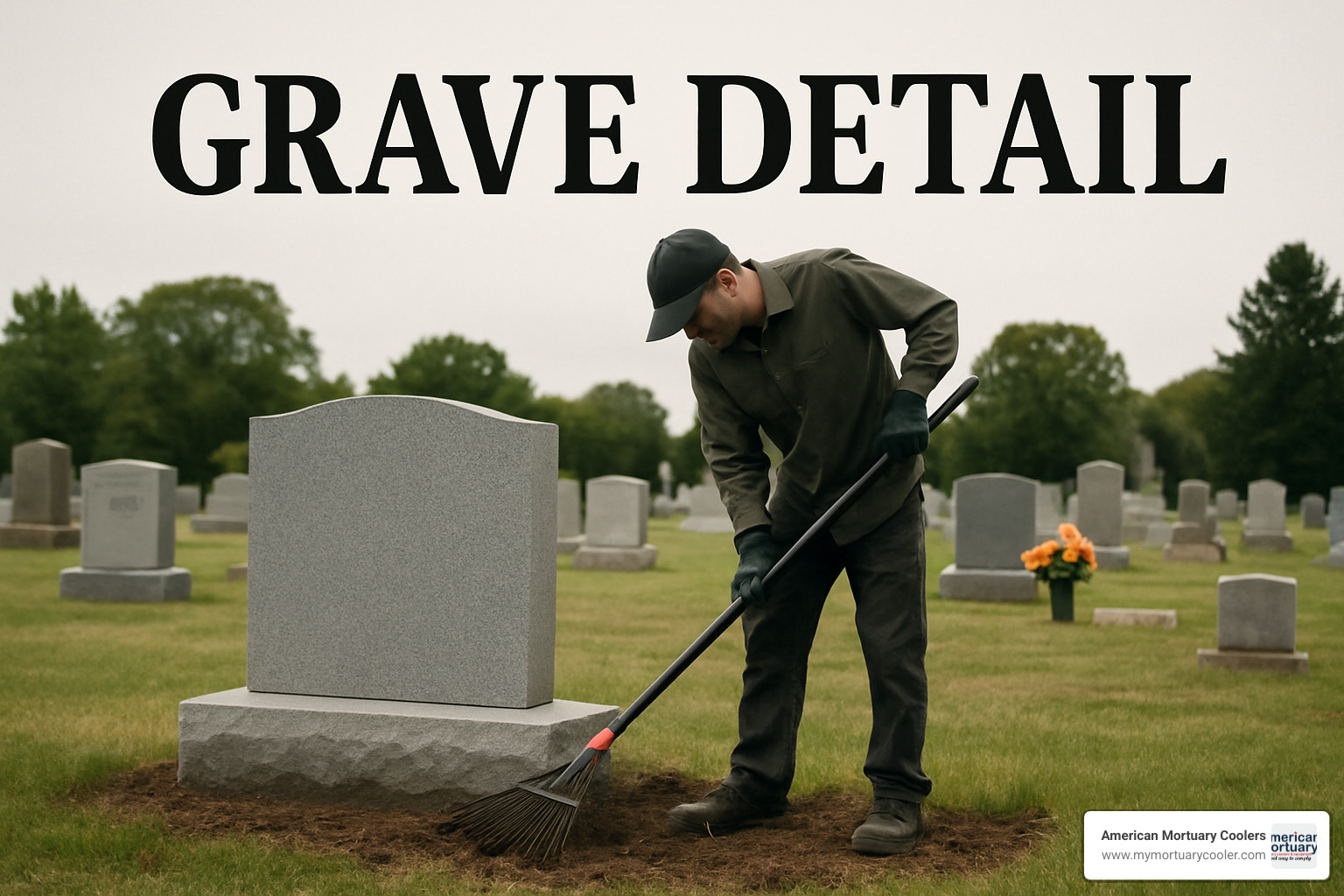
For families searching for their roots, good grave detail provides that irreplaceable bridge to the past. Just look at Find a Grave's remarkable collection of over 250 million memorials created since 1995 – clear evidence of our deep human desire to preserve these connections. Each properly documented grave becomes another thread in the rich mix of family history, helping people understand where they came from and who came before them.
Cemetery managers know that accurate grave detail isn't just nice to have – it's essential. Proper documentation ensures clear proof of ownership, helps cemeteries comply with local regulations, enables smart space planning, prevents accidental disturbance of existing graves, and makes future maintenance possible. Without good records, chaos would quickly ensue.
But there's something more profound happening in our cemeteries. They're outdoor museums that tell the story of who we are as a community and a culture. The inscriptions, symbols, and arrangement of graves speak volumes about historical events, changing attitudes toward death, and what we value most. A Civil War veteran's simple marker stands in silent testimony to sacrifice, while an ornate Victorian monument reveals different sensibilities about remembrance.
At American Mortuary Coolers, we understand this connection between preserving remains and preserving stories. Our equipment supports the dignified care of the deceased while cemetery professionals handle the detailed documentation that ensures their memory endures.
Documentation & Record-Keeping in Grave Detail
Good grave detail requires thorough documentation across multiple dimensions. It starts with the physical marker – whether that's a modest $500 flat marker or an elaborate $3,500 monument. These markers typically include the full name of the deceased, birth and death dates, family relationships, religious symbols, military service details, and personal epitaphs that capture something essential about the person's life or beliefs.
But the visible marker is just the beginning. Behind the scenes, comprehensive grave detail includes cemetery records documenting exact plot location, burial depth, ownership information, perpetual care arrangements, monument specifications, and interment details. These records are the invisible infrastructure that makes cemetery management possible.
Today's cemetery professionals have moved beyond dusty ledger books to accept digital systems that integrate traditional records with GIS mapping technology. The City of Beavercreek's "Grave Find" software shows how modern technology improves grave detail management – allowing searches by name, age, birth date, death date, and availability status, all connected to interactive maps that make location simple.
The humble name plate or marker serves as the primary reference point for all other records in the grave detail system. Without this physical identifier, connecting records becomes nearly impossible. If you're considering options for cemetery markers, our guide to choosing cemetery name plates offers helpful guidance.
Ethical & Cultural Considerations of Sharing Grave Detail
While preserving grave detail is vital, sharing this information requires thoughtfulness and sensitivity. The digital age has transformed how burial information circulates, with platforms like Find a Grave making millions of memorial records just a click away. This accessibility brings both benefits and challenges.
When working with grave detail, cemetery professionals and researchers need to consider several ethical dimensions. Privacy concerns remain relevant even after death, particularly for recent burials. Cultural and religious practices may include specific protocols about how death information is shared. Sites connected to historical trauma require extra care in documentation and presentation. And repatriation issues are especially important when dealing with indigenous communities' ancestral remains.
Best practices for ethical handling of grave detail have evolved over time. When possible, getting permission from family members shows respect, especially for recent burials. Following cemetery rules about photography and documentation is essential. Being mindful of cultural contexts helps avoid unintentional harm. Providing historical context honors the deceased's life circumstances rather than reducing them to dates on a stone. And following established guidelines for historical documentation ensures consistency and quality.
For those interested in contributing to public grave documentation efforts, resources like the Find a Grave Forums offer guidance on respectfully transcribing and photographing grave markers.
At American Mortuary Coolers, we see our role in the funeral industry as connected to these ethical considerations. Our equipment supports the dignified handling of remains – the crucial first step in ensuring respectful grave detail documentation that will stand the test of time.
How Professionals Capture and Preserve Grave Detail
Professional grave detail services blend traditional methods with modern technology to create thorough records that serve both today's needs and tomorrow's researchers. This important work crosses several disciplines, from stone preservation to digital archiving – all requiring specialized knowledge and careful attention.

When a cemetery professional documents a grave, they typically start with the physical marker itself. They'll carefully transcribe all text and numbers, measure the monument, note what materials were used (granite, marble, bronze), and document any symbols or decorative elements. They'll take high-resolution photos from multiple angles and assess whether the marker needs any preservation work.
All this information then flows into broader record-keeping systems that place each grave within its proper cemetery context. Today's cemetery management software can integrate this data with GPS coordinates, interactive maps, searchable databases, and maintenance schedules – creating a complete picture of each burial site.
At American Mortuary Coolers, we understand that proper preservation begins long before the burial. Our mortuary equipment is designed to maintain the dignity and integrity of the deceased, which directly connects to the accuracy and respect reflected in their grave detail records later on.
Traditional Methods: From Stone Chisels to WWI Graves Registration
The story of grave detail documentation reflects our evolving relationship with death and remembrance throughout history. What we do today builds on centuries of traditional practices.
Early American gravestones were truly "written in stone" – with slate, sandstone, and later marble markers serving as the primary record of a person's life. Stone carvers were the original grave detail specialists, developing techniques to create inscriptions that could withstand centuries of rain, snow, and sun. These craftsmen combined artistic skill with practical knowledge of materials to create lasting memorials.
Military conflicts dramatically advanced how we document burials. During the Civil War, the U.S. government began systematically identifying and recording military burials, though many soldiers still ended up in unmarked graves. By World War I, these efforts had evolved into the formal Graves Registration Service – a turning point in grave detail history.
The WWI Graves Registration Service created detailed card registers for American soldiers who died overseas between 1917 and 1922. These cards captured the soldier's name, rank, serial number, unit, cause of death, burial location, and next of kin information. This system became the foundation for both overseas American military cemeteries and the return of remains to grieving families back home.
For history buffs and family researchers, the Graves Registration Card Registers from 1917-22 offer fascinating insights into these early standardized grave detail practices.
Modern Tools Elevating Grave Detail Services
Today's grave detail professionals have tools that would amaze cemetery workers from previous generations. These technologies have transformed how we document, preserve, and share burial information.
Geographic Information Systems (GIS) have revolutionized cemetery mapping by creating layered maps showing both above-ground features and below-ground burials. These systems link spatial data with biographical information, generate 3D models of cemetery landscapes, track available spaces, and document how cemetery layouts have changed over time.
Digital photography has also transformed grave detail work. High-resolution images capture the finest details on weathered stones. Photogrammetry creates 3D models of monuments. Specialized techniques like Reflectance Change Imaging (RTI) can reveal inscriptions that have worn away and become invisible to the naked eye. Even drone photography now offers new perspectives for aerial documentation.
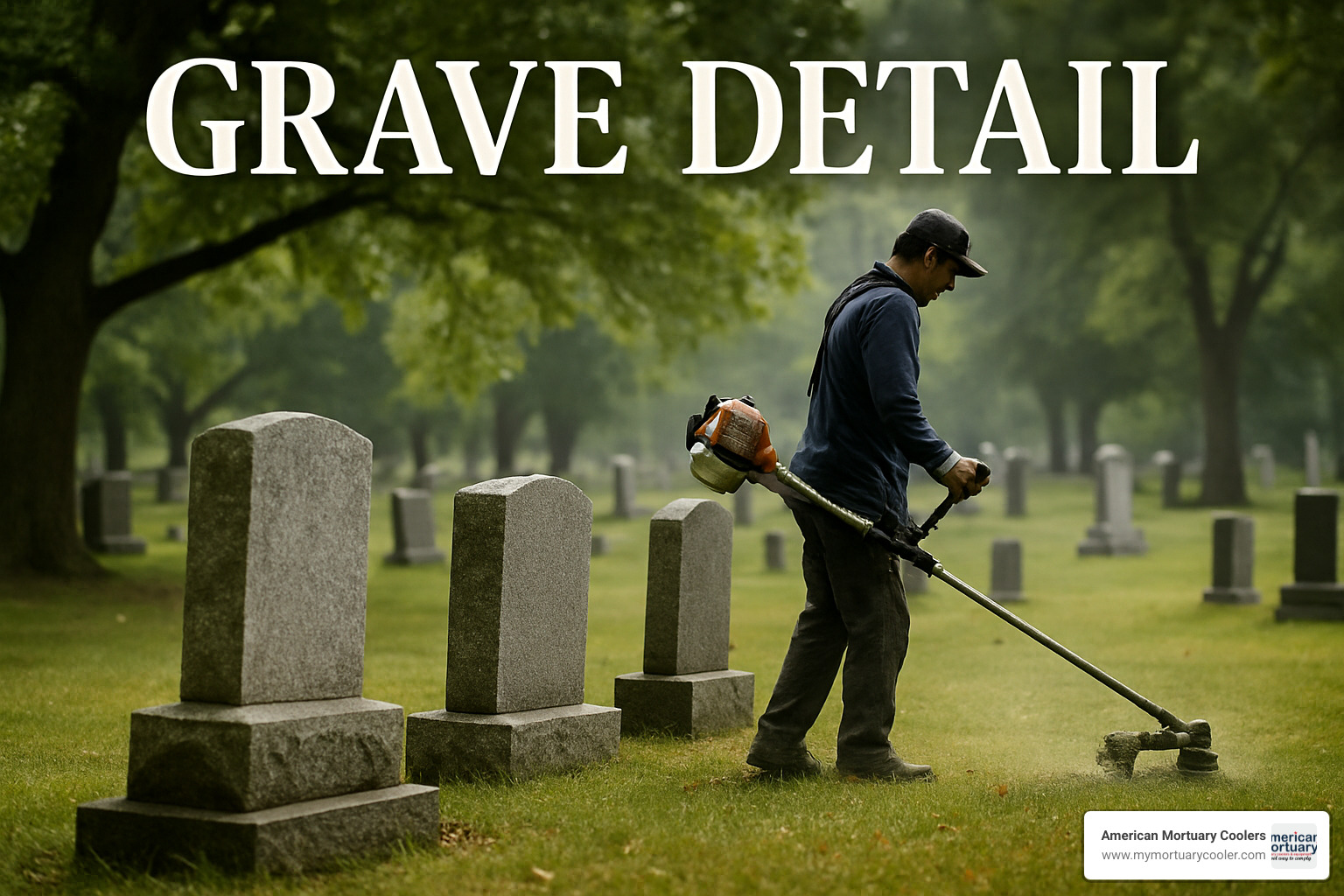
Modern database systems bring all this information together in user-friendly platforms. The City of Beavercreek's "Grave Find" software is a perfect example – visitors can search by multiple criteria and view results on interactive maps with satellite imagery and detailed lot overlays.
Some forward-thinking cemeteries now incorporate QR codes on newer markers or signs. Visitors can scan these codes with their smartphones to access online memorials with expanded biographies, photographs, and family connections – bringing grave detail into the digital age.
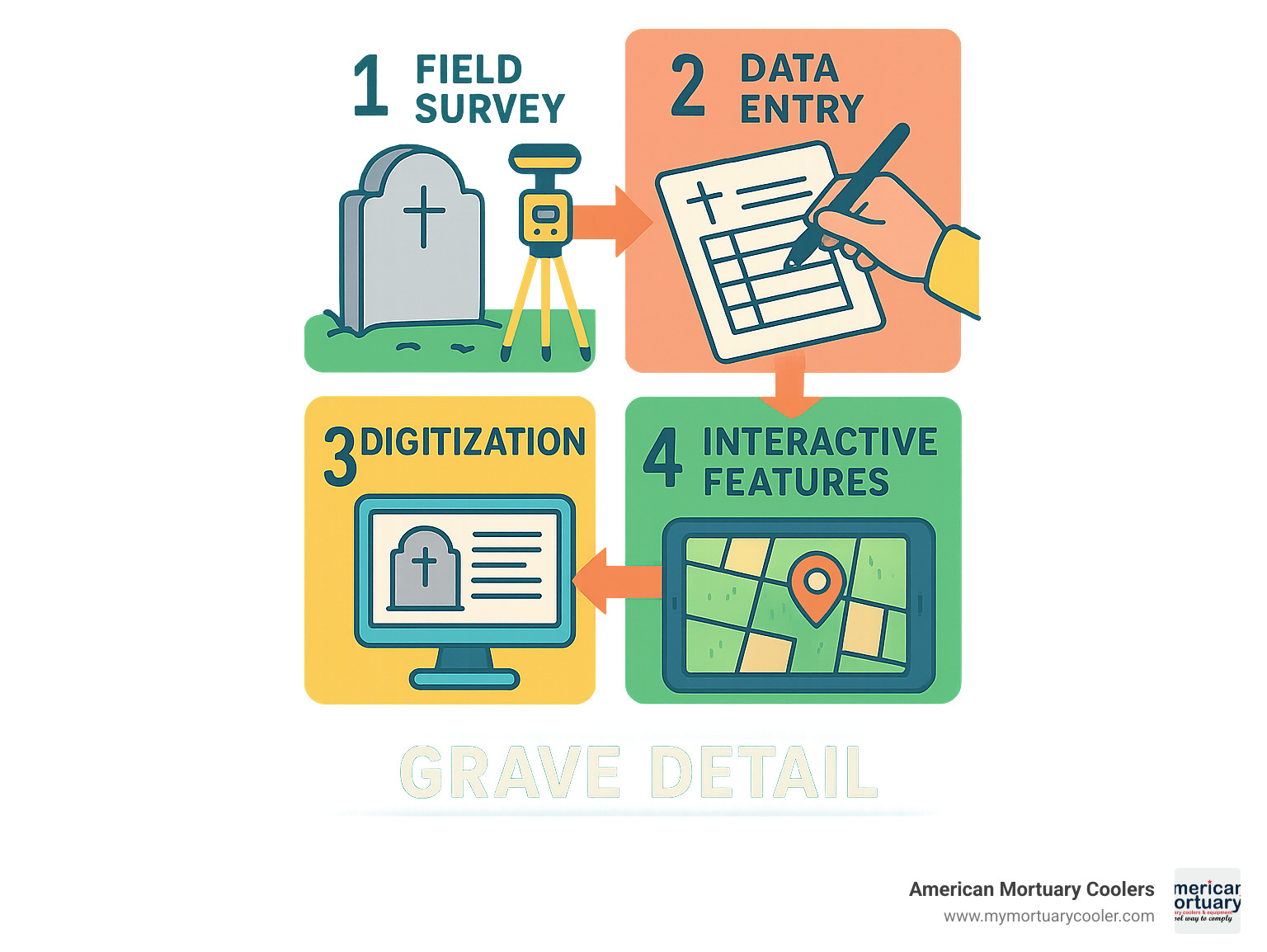
At American Mortuary Coolers, we see our role as supporting this entire process through equipment that facilitates proper handling from the moment of death. Our mortuary coolers ensure that dignity is maintained throughout the journey that ultimately leads to a permanent grave detail record.
Maintenance & Restoration Best Practices
Preserving grave detail for future generations requires ongoing care of both physical markers and their associated records. Professional cemetery services follow careful practices to protect these important cultural artifacts.
When it comes to cleaning markers, gentle methods are now standard. Deionized water is preferred because it contains no minerals that might damage stone over time. Any cleaning solutions should maintain a neutral pH (around 8) to prevent deterioration. Professionals avoid pressure washing and wire brushes that can erode inscriptions – instead opting for soft brushes and patience.
Regular maintenance makes a huge difference. Scheduling cleaning every 3-4 months prevents buildup that becomes harder to remove later. Documenting the condition with before-and-after photographs helps track changes over time and plan for future preservation needs.
For damaged markers, restoration requires specialized expertise. Grave detail restoration might include resetting tilted monuments, repairing broken stones with appropriate adhesives, repointing degraded mortar, cleaning biological growth like lichen and moss, and carefully enhancing illegible inscriptions without damaging the original stone.
Digital records need maintenance too. Best practices include regular backups to multiple secure locations, periodic verification against physical markers, updating records when restoration work happens, and creating redundant systems that will survive technological changes over decades.
For families who want to maintain grave sites between professional cleanings, seasonal decorations add a personal touch. If you're considering floral arrangements, our guide on choosing the right sympathy flowers offers thoughtful suggestions.
At American Mortuary Coolers, we understand that preservation is a continuous process. Just as our cooling systems are designed for long-term reliability, proper grave detail practices ensure that memorials and their associated records endure for generations to come.
Ordering Grave Detail Services the Right Way
Finding the right professional for grave detail services doesn't have to be overwhelming. Whether you're documenting your family's historic cemetery plot, selecting a new memorial, or restoring weathered markers, understanding your options will help you steer this meaningful process with confidence.
I've seen families approach this decision from many different angles, and the first step is always identifying exactly what level of service you need:
A basic documentation package captures the essentials—photographs, inscription transcriptions, and precise location records. If you're establishing a new memorial, you'll need marker installation services that handle selection, engraving, and proper placement. For historical graves, restoration services provide specialized cleaning, repair, and preservation of existing markers. Many families opt for comprehensive packages that combine documentation, physical work, and ongoing maintenance plans.
When I talk with funeral directors about grave detail specialists, I always emphasize the importance of credentials. Look for professionals who belong to organizations like the Association for Gravestone Studies. Ask to see examples of their previous work, especially for projects similar to yours. The best providers will readily share their knowledge of preservation techniques and demonstrate familiarity with local cemetery regulations.
At American Mortuary Coolers, we've built relationships with cemetery professionals nationwide. From our home base in Tennessee to our clients in Los Angeles, we're happy to connect funeral homes with reputable grave detail specialists in their regions who share our commitment to dignity and respect.
Key Questions to Ask Before You Hire
I've found that asking the right questions upfront prevents disappointment later. Here are the conversations you should have before committing to any grave detail service:
Start by asking about cemetery restrictions: "What are the cemetery's rules about marker types, sizes, and materials?" Many people don't realize how specific these regulations can be until they've already set their hearts on a particular design.
Material choices matter tremendously for long-term preservation. Ask: "What materials work best in our climate, and how will they age over time?" Granite might be perfect in one region but problematic in another.
Be specific about documentation: "What records will I receive, and in what format?" Good providers will offer comprehensive documentation including high-resolution photographs, precise measurements, and GPS location data.
Timeframe expectations are crucial—ask how long the process will take from order to installation. I've seen simple markers take 10 weeks while custom monuments might require six months or more.
Don't forget to discuss warranty coverage. A reputable provider will clearly explain what's covered, for how long, and how repairs are handled if needed.
For historical marker restoration, verify their approach: "What restoration methods do you use, and do they comply with preservation standards?" The wrong techniques can permanently damage irreplaceable artifacts.
| Feature | Flat Markers | Upright Monuments | Specialty Markers |
|---|---|---|---|
| Cost Range | $500-$5,000+ | $1,500-$3,500+ | $5,000-$15,000+ |
| Installation Complexity | Lower | Higher | Highest |
| Maintenance Needs | Lower (mow-over design) | Moderate | Varies by design |
| Customization Options | Limited by size | Extensive | Unlimited |
| Cemetery Restrictions | Widely accepted | Sometimes restricted | Often restricted |
| Detail Preservation | Good | Excellent | Varies by design |
| Installation Time | 2-3 months | 3-6 months | 6+ months |
This comparison helps illustrate how your marker choice affects both initial documentation needs and long-term preservation requirements.
Budgeting for Grave Detail: What the Numbers Say
Let's talk frankly about costs. Planning for grave detail services is easier when you understand the typical price ranges involved.
For the markers themselves, expect to pay $500 to $5,000+ for flat grave markers depending on size and material. Upright monuments generally start around $1,500 and can exceed $3,500 for standard designs. Specialty markers like custom benches or sculptures start around $5,000 and can reach $15,000 or more for truly unique pieces.
Material choices significantly impact both price and longevity. Bronze markers typically cost more than stone options of similar size. Granite costs less than marble and generally requires less maintenance over time—something worth considering for long-term grave detail preservation.
The personalization that makes a marker meaningful adds to the cost: basic engraving with a name and dates runs about $500, with additional lettering costing $10-$25 per character. Custom designs or portraits range from $300 to $1,500 depending on complexity.
Don't forget installation costs, which can surprise families who haven't budgeted for them. Professional installation ranges from $200 to $2,000 depending on the marker's size and the cemetery's location. Foundation preparation adds another $200-$800, and permit fees typically run $50-$300 depending on local regulations.
If you're investing in professional documentation, expect to pay $100-$500 for photography and basic recording. Condition assessments for historical markers typically cost $200-$600, while creating integrated digital records adds $150-$500 to the project.
Ongoing maintenance ensures your investment retains its grave detail integrity. Professional quarterly cleaning runs $75-$200 per visit, with annual preservation treatments adding $100-$300. Repair costs vary widely depending on the type and extent of damage.
These figures reflect national averages—I always recommend getting detailed quotes from multiple providers in your area for the most accurate picture.
Integrating "Grave Detail" with Broader Memorial Planning
I've noticed that families who approach grave detail as part of a cohesive memorial plan create more meaningful and lasting tributes. These services represent just one piece of a larger process that honors a life.
The journey typically begins with immediate arrangements—working with funeral homes on services and temporary care. Cemetery selection follows, establishing where your loved one's permanent memorial will be located. Then comes grave marker planning, where you select and design the physical memorial that will stand for generations. Proper documentation ensures all burial information is accurately recorded, while long-term maintenance plans preserve the integrity of both the physical marker and its information.
Each decision influences the others. For instance, your choice of burial container affects what type of marker can be used, while cemetery policies determine both marker options and maintenance requirements.
Traditional elements like funeral biers play an important ceremonial role in this process. These structures transport the casket to the gravesite—establishing the physical location that will become the focus of grave detail documentation. Our guide on funeral biers meaning and traditions explores this meaningful practice in depth.
At American Mortuary Coolers, we understand our role in this continuum of care. Our custom mortuary coolers and equipment support funeral professionals in maintaining dignity from the moment of death through final memorialization. The proper handling of remains contributes directly to the respect reflected in permanent grave detail records that will stand for generations.
Historical Moments Where Grave Detail Shaped the Record
Throughout history, certain events have highlighted just how crucial thorough grave detail documentation truly is. These historical examples show us that burial records serve not just grieving families in the moment, but become vital threads in our broader historical and cultural mix.
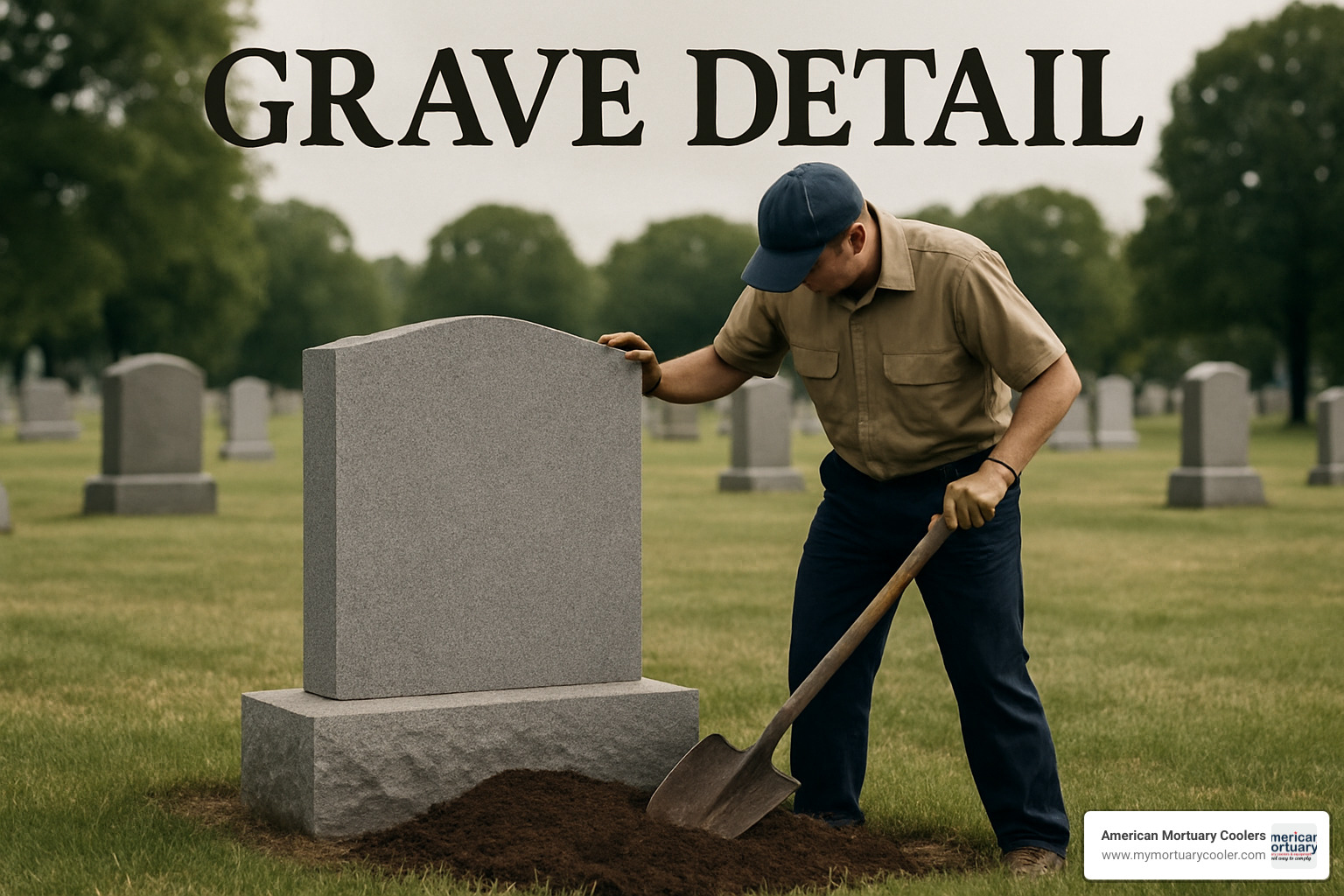
The Titanic Disaster (1912)
When the RMS Titanic sank beneath the icy Atlantic waters, it created unprecedented challenges in victim identification and burial documentation. The numbers tell a sobering story – of approximately 1,500 souls lost, recovery ships found only 337 bodies. What happened next reveals the complexity of disaster response when faced with mass casualties.
The recovery teams made difficult decisions based on condition and resources. About 119 bodies were respectfully committed to the sea due to advanced decomposition. In Halifax, Nova Scotia, 150 victims found their final rest across three cemeteries. Just 59 bodies were claimed and returned to waiting families.
What makes this tragedy remarkable from a grave detail perspective is the meticulous record-keeping maintained throughout this chaotic period. The White Star Line funded simple yet dignified granite markers for each Halifax burial, each bearing the victim's name and death date. These markers, arranged in solemn rows, create a landscape of remembrance that still draws visitors over a century later.
Thanks to these careful records, historians and descendants can still identify and locate victims' final resting places – connecting modern visitors with this profound historical moment.
Royal National Lifeboat Institution Memorials
The story of Britain's RNLI presents a different but equally moving example of grave detail significance. Since its founding, this organization has saved nearly 150,000 lives – an astonishing achievement that came at the cost of over 600 volunteer rescuers who perished while trying to save others.
Walk through coastal cemeteries in Britain and you'll notice something distinctive about RNLI memorials. Many feature unique imagery of lifeboats and rescue equipment – a visual language that immediately identifies the deceased's connection to this lifesaving organization. These aren't just markers for individuals; collectively, they tell the story of coastal communities and their complex relationship with the sea.
The grave detail preserved in these memorials serves dual purposes – honoring personal sacrifice while creating a public record of service that might otherwise be forgotten. Each marker represents not just a life lost, but a story of extraordinary courage.
World War II Normandy American Cemetery
Perhaps no event tested modern grave detail systems more than World War II. The D-Day invasion and subsequent Normandy Campaign resulted in thousands of American casualties, creating an enormous documentation challenge under the most difficult circumstances imaginable.
The Quartermaster Graves Registration Service rose to this challenge with remarkable organization. They deployed specialized companies that established temporary battlefield cemeteries while maintaining precise documentation. Using standardized forms (GR Form No.1 & No.2), these teams created records that included exact location information with sketches and landmarks. Identification bottles and dog tags helped ensure accurate records, while systematic battlefield searches attempted to recover every fallen soldier.
By September 1944, the scale of this operation was staggering – 21 Graves Registration Companies with 2,645 personnel were operating throughout the European Theater. They documented over 21,000 American burials from the Normandy campaign alone. This meticulous grave detail work made possible both the beautiful permanent cemetery at Colleville-sur-Mer and the repatriation of many remains to grieving families in the United States after the war.
At American Mortuary Coolers, we find these historical examples deeply moving. They demonstrate how grave detail documentation serves multiple purposes – from providing closure to families to creating permanent historical records that help us understand significant events. We're proud to be part of an industry with such a long tradition of dignified and detailed record-keeping, and we design our mortuary equipment with this same respect for the deceased and their lasting memory.
Frequently Asked Questions about Grave Detail
What information is essential for a complete grave detail record?
When families ask me what should be included in their loved one's grave detail record, I always emphasize that thoroughness now prevents heartache later. A complete record becomes a lasting gift to future generations.
At its core, a comprehensive grave detail record captures both the practical information and the human story. It starts with the basics—the person's full legal name, dates of birth and death, and age at passing. But it shouldn't stop there.
Location details matter tremendously, especially as years pass. Include the cemetery name, section, lot, and grave number. Modern records often add GPS coordinates, which can be invaluable when physical markers deteriorate or landscapes change over decades.
The physical marker itself deserves careful documentation—what material was used? What are its dimensions? Is it upright or flat? What condition was it in when last inspected? This information helps tremendously with future maintenance and preservation efforts.
Perhaps most precious is a complete transcription of the inscription. Every word, symbol, and decorative element tells part of a story. I've seen families deeply moved when finding an ancestor's epitaph that perfectly captured their spirit.
High-quality photographs from multiple angles provide visual documentation that words alone cannot. Close-ups of inscriptions are particularly valuable as weathering may eventually make the original text difficult to read.
Adding historical context enriches the record immeasurably—military service, family relationships, community contributions, and even cause of death when appropriate. These details transform a simple marker into a meaningful historical document.
For long-term care, include the marker's installation date, any restoration work performed, and regular condition assessments. Don't forget to document ownership information—who holds the deed, what perpetual care arrangements exist, and contact information for responsible family members.
At American Mortuary Coolers, we've seen how these detailed records become treasured family resources, especially when maintained in multiple locations for safekeeping.
How do digital grave registries protect privacy?
The digital age has transformed how we preserve grave detail, but it also raises important privacy considerations. Finding the right balance between accessibility and privacy protection is something I discuss frequently with our funeral home partners.
Digital registries typically employ a thoughtful approach to privacy. Most reputable platforms create tiered access systems where basic information—name, dates, location—remains publicly searchable, while more sensitive details require family authentication. This approach serves both genealogical researchers and protects family privacy.
Time-based restrictions often govern what information becomes available when. Recent burials typically receive higher privacy protections that gradually relax as decades pass. This recognizes that privacy concerns naturally diminish over generations while historical value increases.
Family control remains paramount in quality systems. Good platforms provide clear opt-out provisions allowing families to limit what information appears online. This might include restricting photographs, removing cause of death information, or limiting biographical details.
Behind the scenes, content moderation plays a crucial role. Photos and comments should undergo review before publication to prevent inappropriate or distressing content. Additional protections typically apply to children's graves, with many platforms implementing special restrictions for burials of minors.
When choosing a digital platform for preserving grave detail, I always recommend reviewing the privacy policy carefully. The best services clearly explain what information will be publicly visible and provide straightforward mechanisms for families to control their loved one's digital memorial.
It's worth noting that historical graves—typically those over 50-100 years old—generally receive fewer privacy restrictions. This reflects their important role in documenting community history and genealogical research. Even so, thoughtful platforms maintain standards of dignity and respect regardless of a burial's age.
Can I update an existing headstone to add missing grave detail?
"My grandmother's headstone doesn't mention her remarkable military service. Can we add that now?" This question comes up frequently, and I'm always glad to share that yes, updating existing markers is often possible.
The approach depends largely on the type of marker and your cemetery's specific regulations. For many stone markers, additional engraving can add missing information if there's available space. The best results come when working with an experienced stone carver who can match the original style and depth of carving.
When space is limited or the original marker shouldn't be altered, supplemental markers offer an excellent solution. Small plaques or footstones can provide additional grave detail without changing the primary monument. I've seen beautiful examples where military service plaques or small family relationship markers complement the original headstone perfectly.
Sometimes the best option is a complete replacement, particularly when significant information is missing or the original marker shows serious deterioration. Many families choose to preserve elements of the original marker—perhaps incorporating a piece of the old stone into the new design or preserving the original elsewhere as a family keepsake.
Technology has created interesting new possibilities too. Some cemeteries now permit small, discreet QR code plaques that link to expanded digital memorials. This approach beautifully bridges physical and digital remembrance, preserving the historical integrity of the marker while providing access to unlimited additional grave detail online.
Before making any changes, there are important steps to take. First, obtain permission from the cemetery administration—they typically have specific policies about marker modifications. Verify that you have the legal right to make changes by confirming ownership of the burial plot. Local regulations may also govern what alterations are permitted, particularly in historic cemeteries.
At American Mortuary Coolers, we're happy to connect funeral professionals with qualified monument specialists in their area. These experts can provide guidance on respectfully updating grave detail while honoring both family wishes and historical integrity. The goal is always the same—ensuring that each person's story is told completely and accurately for generations to come.
Conclusion
The practice of documenting and maintaining grave detail represents one of humanity's most enduring traditions—our collective effort to preserve the memory of those who came before us. From simple wooden markers to elaborate monuments, from handwritten ledgers to sophisticated digital databases, the evolution of grave detail practices reflects our deep human need to honor and remember.
Throughout history, we've found ways to mark final resting places with care and intention. Today's comprehensive grave detail services blend time-honored traditions with modern innovation, creating records that serve both present needs and future generations. The stone carver of yesterday and the digital archivist of today share a common purpose—ensuring that lives are remembered with dignity and accuracy.
What makes truly effective grave detail work stand out is the thoughtful combination of physical care and meticulous documentation. When a marker is properly installed, when inscriptions are clearly recorded, when location data is precisely mapped—these details create a lasting legacy that families can return to for generations.
At American Mortuary Coolers, we understand our place in this meaningful chain of care. Our Tennessee-crafted mortuary coolers might seem far removed from cemetery documentation, but we see our work as the crucial first link. By providing funeral professionals with reliable, custom-designed equipment, we help ensure that dignity and care begin at the moment of death—setting the stage for all the grave detail work that follows.
I've seen how digital change has opened remarkable new possibilities in grave detail practices. Today's families can access rich biographical information, photographs, and historical context regardless of where they live. A grandmother in California can show her grandchildren their ancestors' graves in New York without boarding a plane. A researcher in England can trace family connections to American pioneers without crossing the Atlantic.
For funeral professionals looking to improve their grave detail services, I recommend balancing tradition and innovation. The most meaningful approaches honor historical practices while embracing technologies that make records more accessible and durable. Your families will appreciate both the reverence for tradition and the convenience of modern access.
The work of preserving grave detail goes beyond simple record-keeping—it's about preserving human stories. Each carefully documented grave represents a life lived, connections formed, and legacies left behind. When we take the time to document these details properly, we're saying that these lives matter and deserve to be remembered.
To learn more about how our mortuary equipment supports the dignity that underlies meaningful grave detail practices, visit our guide on comprehensive mortuary solutions.
By maintaining meticulous grave detail, we do more than serve grieving families—we contribute to our collective memory as a society. We ensure that the stories, relationships, and contributions of those who came before us continue to inform and inspire future generations. In this way, even the smallest details of documentation become part of something profoundly meaningful and enduring.
















